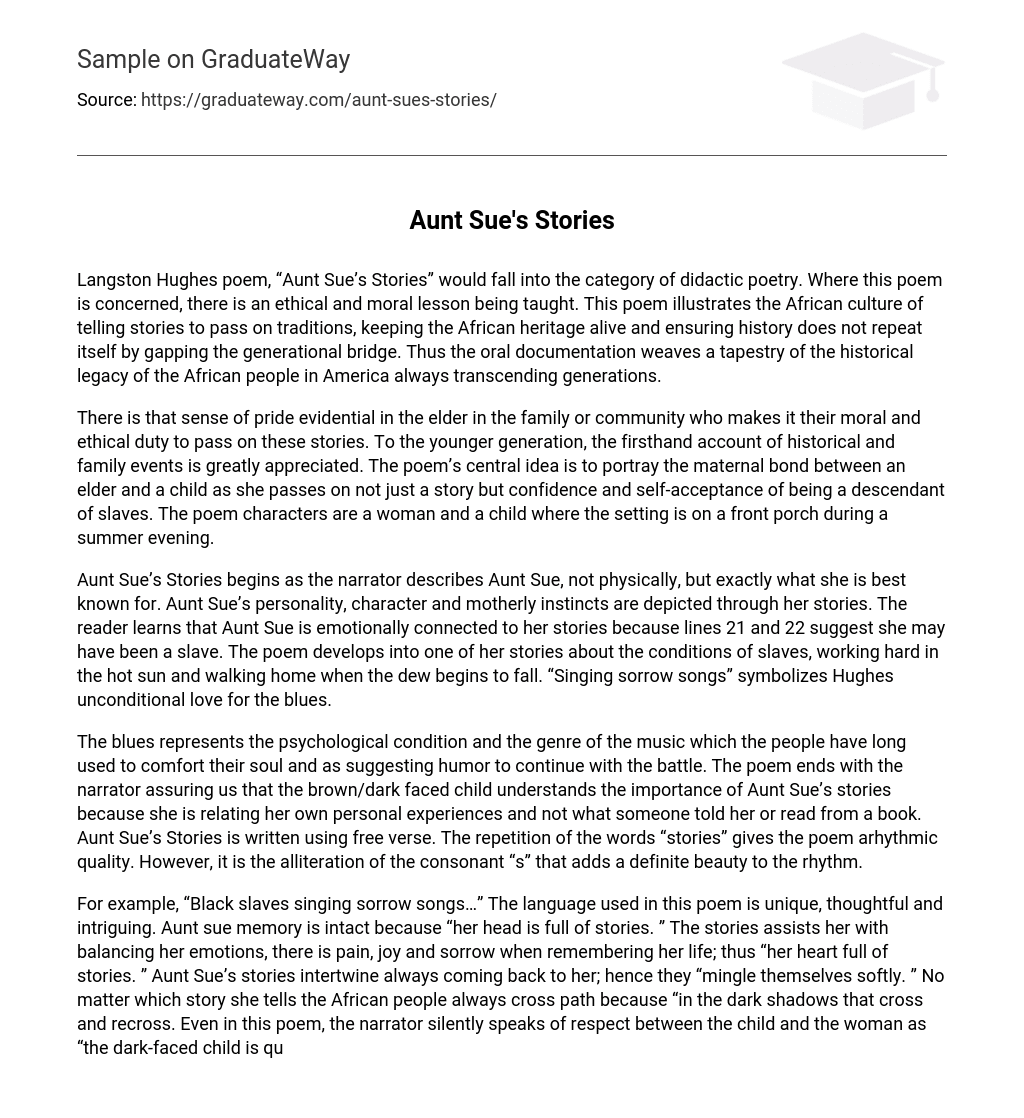Langston Hughes poem, “Aunt Sue’s Stories” would fall into the category of didactic poetry. Where this poem is concerned, there is an ethical and moral lesson being taught. This poem illustrates the African culture of telling stories to pass on traditions, keeping the African heritage alive and ensuring history does not repeat itself by gapping the generational bridge. Thus the oral documentation weaves a tapestry of the historical legacy of the African people in America always transcending generations.
There is that sense of pride evidential in the elder in the family or community who makes it their moral and ethical duty to pass on these stories. To the younger generation, the firsthand account of historical and family events is greatly appreciated. The poem’s central idea is to portray the maternal bond between an elder and a child as she passes on not just a story but confidence and self-acceptance of being a descendant of slaves. The poem characters are a woman and a child where the setting is on a front porch during a summer evening.
Aunt Sue’s Stories begins as the narrator describes Aunt Sue, not physically, but exactly what she is best known for. Aunt Sue’s personality, character and motherly instincts are depicted through her stories. The reader learns that Aunt Sue is emotionally connected to her stories because lines 21 and 22 suggest she may have been a slave. The poem develops into one of her stories about the conditions of slaves, working hard in the hot sun and walking home when the dew begins to fall. “Singing sorrow songs” symbolizes Hughes unconditional love for the blues.
The blues represents the psychological condition and the genre of the music which the people have long used to comfort their soul and as suggesting humor to continue with the battle. The poem ends with the narrator assuring us that the brown/dark faced child understands the importance of Aunt Sue’s stories because she is relating her own personal experiences and not what someone told her or read from a book. Aunt Sue’s Stories is written using free verse. The repetition of the words “stories” gives the poem arhythmic quality. However, it is the alliteration of the consonant “s” that adds a definite beauty to the rhythm.
For example, “Black slaves singing sorrow songs…” The language used in this poem is unique, thoughtful and intriguing. Aunt sue memory is intact because “her head is full of stories. ” The stories assists her with balancing her emotions, there is pain, joy and sorrow when remembering her life; thus “her heart full of stories. ” Aunt Sue’s stories intertwine always coming back to her; hence they “mingle themselves softly. ” No matter which story she tells the African people always cross path because “in the dark shadows that cross and recross.
Even in this poem, the narrator silently speaks of respect between the child and the woman as “the dark-faced child is quiet and the dark-faced child, listening. ” This poem is distinctive in the way it paints a vivid picture of a woman embracing a child. The picture lingers in the readers’ minds as they progress with the narrator’s perception of Aunt Sue. The descriptive words to paint this picture are not readily available to the reader, however, the senses of sight, touch and smell. There is that imaginable sight of a summer evening, the sparsely lit skies, people sitting on their porch to indulge in neighbors and conversations.
This poem reflects that childhood memory of the narrator who is reflecting on his very own summer night. The narrator touches the reader with the bonding between the woman and child. The touch re-affirms what has been missing from the Black community. Just imagine the smell as the wind slightly moves the perfume of cooking from everyone’s house to the smell of a just showered child embraced in the incense of an elder. Langston Hughes used a lyrical approach to create tensions throughout this poem. There is a heightened sense of emotion as the reader reads, “Aunt Sue cuddles a brown-faced child to her bosom, and tells him stories. “Cuddles” best shows the affection for the child.
The reader can envision the bond between woman and child, the sincerity of the embrace and the unprofessed love for the child by sharing personal experiences. These personal experiences will enable the child to have a better understanding of where he/she came from and what needs to be done to continue excelling beyond anyone’s expectations. It was very important of the author to bring forth his tone in this poem because he is one of many authorative figures ensuring the light is keep lit where Black empowerment is concerned.
The mere reference to slaves in this poem pushes it on the brink of an allusion. This is an event in history that most people chose to ignore while others embrace so dearly. Aunt Sue is one of those people who hold dear to the past and sees nothing wrong with passing on this legacy. A tree with no roots is like a person with no idea of his/her past. In order for one to move forward, one must know where they are coming from. In this poem Aunt Sue is creating and promoting a strong sense of cultural and racial identity.





